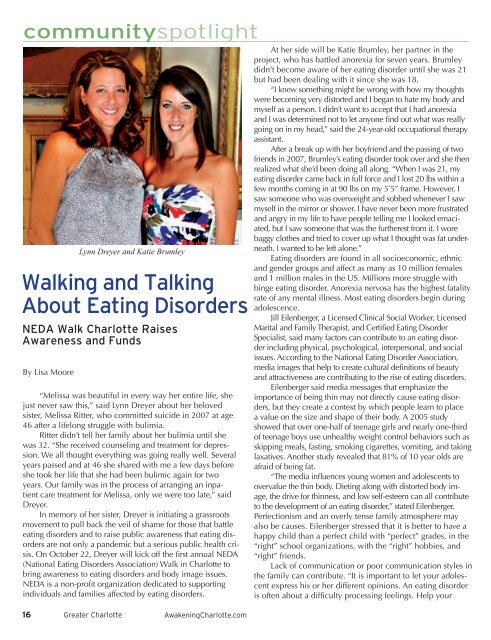green living blue planet - Natural Awakenings Magazine Charlotte
green living blue planet - Natural Awakenings Magazine Charlotte
green living blue planet - Natural Awakenings Magazine Charlotte
You also want an ePaper? Increase the reach of your titles
YUMPU automatically turns print PDFs into web optimized ePapers that Google loves.
communityspotlight<br />
NEDA Walk <strong>Charlotte</strong> Raises<br />
Awareness and Funds<br />
By Lisa Moore<br />
Lynn Dreyer and Katie Brumley<br />
Walking and Talking<br />
About Eating Disorders<br />
“Melissa was beautiful in every way her entire life, she<br />
just never saw this,” said Lynn Dreyer about her beloved<br />
sister, Melissa Ritter, who committed suicide in 2007 at age<br />
46 after a lifelong struggle with bulimia.<br />
Ritter didn’t tell her family about her bulimia until she<br />
was 32. “She received counseling and treatment for depression.<br />
We all thought everything was going really well. Several<br />
years passed and at 46 she shared with me a few days before<br />
she took her life that she had been bulimic again for two<br />
years. Our family was in the process of arranging an inpatient<br />
care treatment for Melissa, only we were too late,” said<br />
Dreyer.<br />
In memory of her sister, Dreyer is initiating a grassroots<br />
movement to pull back the veil of shame for those that battle<br />
eating disorders and to raise public awareness that eating disorders<br />
are not only a pandemic but a serious public health crisis.<br />
On October 22, Dreyer will kick off the first annual NEDA<br />
(National Eating Disorders Association) Walk in <strong>Charlotte</strong> to<br />
bring awareness to eating disorders and body image issues.<br />
NEDA is a non-profit organization dedicated to supporting<br />
individuals and families affected by eating disorders.<br />
16 Greater <strong>Charlotte</strong> Awakening<strong>Charlotte</strong>.com<br />
At her side will be Katie Brumley, her partner in the<br />
project, who has battled anorexia for seven years. Brumley<br />
didn’t become aware of her eating disorder until she was 21<br />
but had been dealing with it since she was 18.<br />
“I knew something might be wrong with how my thoughts<br />
were becoming very distorted and I began to hate my body and<br />
myself as a person. I didn’t want to accept that I had anorexia<br />
and I was determined not to let anyone find out what was really<br />
going on in my head,” said the 24-year-old occupational therapy<br />
assistant.<br />
After a break up with her boyfriend and the passing of two<br />
friends in 2007, Brumley’s eating disorder took over and she then<br />
realized what she’d been doing all along. “When I was 21, my<br />
eating disorder came back in full force and I lost 20 lbs within a<br />
few months coming in at 90 lbs on my 5’5” frame. However, I<br />
saw someone who was overweight and sobbed whenever I saw<br />
myself in the mirror or shower. I have never been more frustrated<br />
and angry in my life to have people telling me I looked emaciated,<br />
but I saw someone that was the furtherest from it. I wore<br />
baggy clothes and tried to cover up what I thought was fat underneath.<br />
I wanted to be left alone.”<br />
Eating disorders are found in all socioeconomic, ethnic<br />
and gender groups and affect as many as 10 million females<br />
and 1 million males in the US. Millions more struggle with<br />
binge eating disorder. Anorexia nervosa has the highest fatality<br />
rate of any mental illness. Most eating disorders begin during<br />
adolescence.<br />
Jill Eilenberger, a Licensed Clinical Social Worker, Licensed<br />
Marital and Family Therapist, and Certified Eating Disorder<br />
Specialist, said many factors can contribute to an eating disorder<br />
including physical, psychological, interpersonal, and social<br />
issues. According to the National Eating Disorder Association,<br />
media images that help to create cultural definitions of beauty<br />
and attractiveness are contributing to the rise of eating disorders.<br />
Eilenberger said media messages that emphasize the<br />
importance of being thin may not directly cause eating disorders,<br />
but they create a context by which people learn to place<br />
a value on the size and shape of their body. A 2005 study<br />
showed that over one-half of teenage girls and nearly one-third<br />
of teenage boys use unhealthy weight control behaviors such as<br />
skipping meals, fasting, smoking cigarettes, vomiting, and taking<br />
laxatives. Another study revealed that 81% of 10 year olds are<br />
afraid of being fat.<br />
“The media influences young women and adolescents to<br />
overvalue the thin body. Dieting along with distorted body image,<br />
the drive for thinness, and low self-esteem can all contribute<br />
to the development of an eating disorder,” stated Eilenberger.<br />
Perfectionism and an overly tense family atmosphere may<br />
also be causes. Eilenberger stressed that it is better to have a<br />
happy child than a perfect child with “perfect” grades, in the<br />
“right” school organizations, with the “right” hobbies, and<br />
“right” friends.<br />
Lack of communication or poor communication styles in<br />
the family can contribute. “It is important to let your adolescent<br />
express his or her different opinions. An eating disorder<br />
is often about a difficulty processing feelings. Help your







